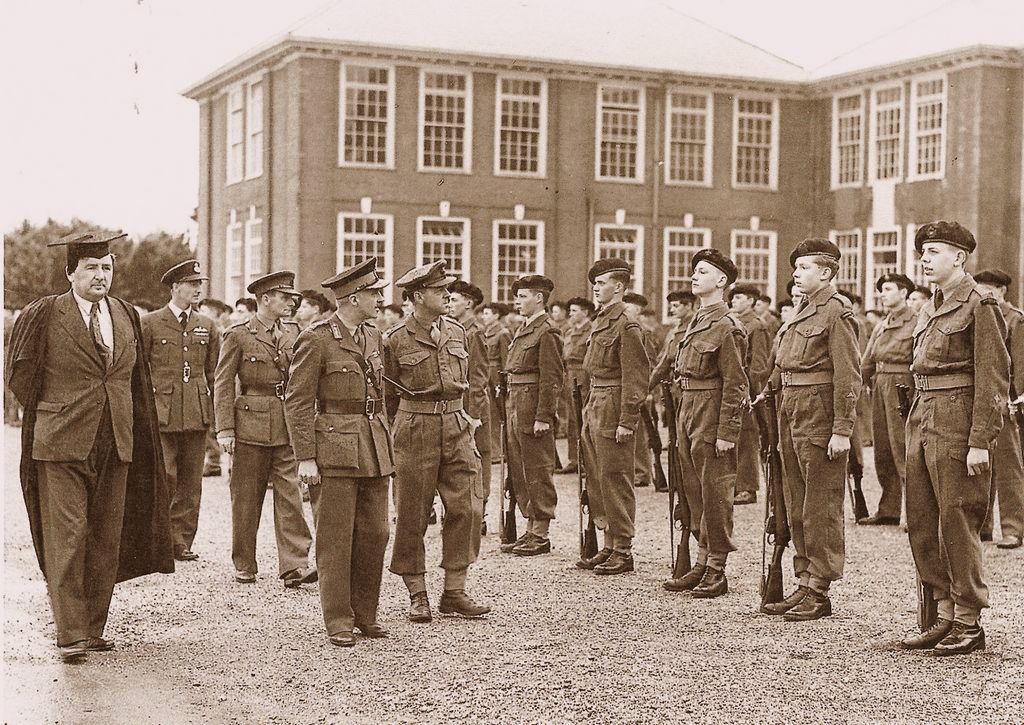RGS High Wycombe Old Boys' Pages
Andrew MacTavish
Tony writes:- CCF Camp, Pirbright 1954
Here is Andrew's account of the experience:-
PIRBRIGHT 1954In a report on the summer camp of 1948 in the Wycombiensian, J.M.K., the R.S.M., said that in all activities, the High Wycombe contingent of 46 was handicapped by insufficient numbers and he ended with a hope that the next time the numbers would rise to 80 or even 90. Now at last, six camps later, this has been realised, for no less than 98 cadets attended this year at Pirbright, in Surrey, and, in spite of whatever the cynics may say, I will add that everyone thoroughly enjoyed themselves. It is probably the demonstrations which stand out clearest among other camp memories, and while the usual “Platoon in Attack” and “Platoon in Defence” were not so well enacted as in previous years, the others were well up to standard. The Royal Armoured Corps gave a display on the very afternoon we arrived and another evening was spent in scrambling in and over a selection of tanks, armoured cars and a D.U.K.W. One of the sergeants in charge said it was the quickest way of ruining them he knew, especially when people would insist on “revving up” the engines, traversing the turrets and generally pushing and pulling every lever they could find. Another afternoon, we marched over to a bombing range, where we saw the firing of a 2 mortar, a 3-in, rocket launcher and a number of Energa anti-tank rifle grenades. In previous years we have seen the mortar firing smoke and the others firing “dummy,” but never before have we seen them firing high explosive. The target for the two anti-tank weapons was a derelict tank, the turret of which had been blown off at some previous date. From our position on the hillside, about 250 yards away, we had a grandstand view and could see the tank reeling under the titanic explosions, especially those of the rockets. The day before we returned home we had a” Farnborough display” to ourselves, with planes from that very station, which was only 5-odd miles away. The R.A.F. people from School would have been in a seventh heaven! Among other incidents, a Comet circled our hill, we were” buzzed” several times by a pair of Meteors and a Canberra, and (from the sublime to the ridiculous!) had a close-up view of a Fiesler Storch, which almost “hung around” our heads. This wierd little machine, which has room for three people and has a stalling speed of 20 m.p.h., was used in North Africa by the Germans both for providing transport for their generals and for reconnaissance purposes— until it was commandeered by some enterprising raiders, since when it has remained at Farnborough. On other days, we saw demonstrations of police dogs and Royal Signals motor cyclists and heard the band of the Royal Horse Guards. This year, we did not manage to get in so much fieldwork as usual, which was a great pity, but there was certainly no lack of enthusiasm when we did go out. Perhaps the most outstanding lesson revealed by these manoeuvres was the poor standard of personal camouflage and concealment, the preliminary patrols of the attackers thus being able to map out the defence positions with little difficulty. “Night Operations “ was one of the highlights of camp as usual and the idea this time was gunrunning, No. 2 platoon being successful in conveying an ammunition chest through No. 1 platoon’s lines. There was no lack of excitement throughout the exercise although the darkness of the night was broken by the Verey lights and the silence by Thunderflashes—and by CpI. S., who was nearly lifted out of a bush by one! The band deserves a special mention, because, for the first time, all the bandsmen went to camp. Few people will readily forget marching back to the station on the last day, led by the band, playing, among other tunes, “The Happy Wanderer,” which may well be said to have been the theme-song of the camp : indeed, at times it nearly drove one crazy, and when the combined bands of the Guards began to play it, it was just about the last straw. As to personal comfort, we were in the lap of military luxury. Being in huts, we had sprung (or rather, army semi-sprung) beds with real mattresses, and veterans of camps long past may well wonder what the army of today is coming to on learning that we had hot water to wash in—not merely lukewarm either, but boiling. The mess was excellent too there was not one meal against which criticism could be levelled, except perhaps the very first we had. There seems to be some form of misguided policy in the army which directs that the first meal is always unappetising, so that the following meals seem even better than they really are by comparison. The fact that we were in huts cut two ways, however, for a higher standard of smartness was expected and was achieved. Each morning everyone spent a busy time after breakfast (or before, as was the custom of the inmates of Hut 11) folding blankets in the approved style, sweeping, dusting shelves, lining up the kits and getting the place in tip-top condition for inspection. Captain Davies had a most difficult job in judging the best hut each day : over the whole week Hut 11 took most honours, the Signals Platoon in Hut 28 coming a close second. There are a thousand and one other incidents and aspects of camp which would take up pages—the two periods on the .303 ranges, the N.A.A.F.I., the excellent camp cinema, to mention but a few—but over all hangs something which only too often is lacking in the C.C.F. periods on a Thursday afternoon, and that is enthusiasm. The “Oh-heck-when-am-I-going-to-get-out-of-this-horrible uniform?” expression on people’s faces was replaced by a.” What- are-we-going-to-do-next?” look, and whatever was afoot, people were enthusiastic and usually excited into the bargain. J.M.K. called camp “ C.C.F. with a difference,” and this is the difference. Unfortunately too many people seem to be inclined to think that camp is one long Thursday afternoon and for this reason they never think of going. But at camp it is all practical work there are no “Thursday-afternoon” type parades, no drill periods and no theory work, and it is at camp alone that a cadet can practice that theory with which he is crammed during the term. Certainly it is an invaluable insight into army life and no cadet ought to feel himself anywhere near proficient until he has attended a camp; arid you do not have to be a regular “ Prussian” type to have the time of your life. J.M.K. wanted to see 80 or 90 people at camp, just about double the number who went that year to ask that now would be a little optimistic, but surely next year we can proudly set down the strength of our contingent in three figures. A. J. MacTAVISH, VIM.(Published in the Wycombiensian September 1954) |
Andrew took these photos:-Herewith the pictures of the Army Section CCF camp at Pirbright 1964. They are not too exciting as they are poor quality. However they do open a little crack into the mistly world of the past. I was given a box camera. These were pretty flimsy things, and I spent some time costructing a box out of 9 ply with a sorbo lining so that I could carry it in an army small pack. It took 12 pictures on a roll of film - and I could afford only one. The camera really needed bright sun and someone with experience... No 1 Platoon with No 2 Platoon behind. Signal Platoon.
Sgt Gittins: Sigs Sgt Regan: Cpl MacTavish Cpl Arnold: Cpl Simmons Cdts Small: Willatts: Bailey: Malin: Moore
CQMS Barri Jones guarding the ammunition on the ranges. He was Head Boy, and later an eminent professor and authority (on Hadrian's Wall, I believe).
4 NCO's firnig Bren LMG's.
I think we held 4 operational guns and 4 DP's.
A demonstration with one of our cadets holding a 3.5" rocket launcher.
|
Here are some more photos from Andrew:-
(Click on any photo for an enlarged version)
CCF General Inspection, probably 1952.This photo is very similar to the one sent in by Tom Baldwin . They were clearly taken within seconds of each other. I can recognise the naval cadet beneath the circular window in both as Green. The army cadet's head to the immediate right of the end front rank naval cadet in both pictures belongs to Warner (Now Professor G Warner, Emeritus Professor of Brasenose College, Oxford). I guess the year is summer 1952 as Warner is parading with A& B Coys (C Coy are behind without rifles). He joined the CCF in 1950/1 with me. By summer 1952 we paraded with the combined B & C Coys.....Of course, we could always ask Terry Williams as he is visible as the Army Section CSM, hands behind back, just to the left of the saluting Navy cadet.. |
Don't miss anything - more to explore in the Site Map
RGS High Wycombe School Photos Website - Tony Hare & John Saunders - Home Page https://www.saund.org.uk/rgs/index.html
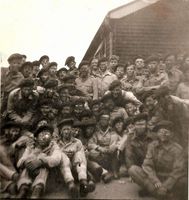
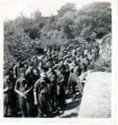
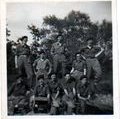
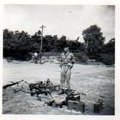
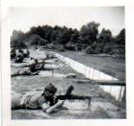
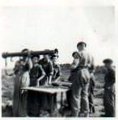
 [640x480].jpg)
 [640x480].jpg)
 [640x480].jpg)
 [640x480].jpg)
